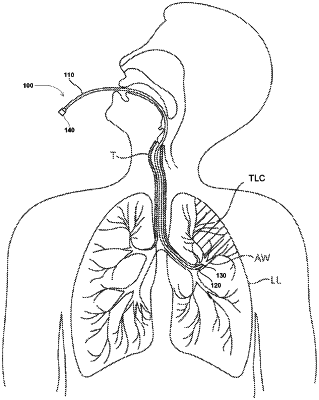| CPC A61B 5/085 (2013.01) [A61B 5/087 (2013.01); A61B 5/097 (2013.01); A61B 5/6853 (2013.01); A61B 5/7278 (2013.01); A61B 2562/0247 (2013.01)] | 20 Claims |

|
1. A method for determining a disease state of a portion of a lung in a patient, the method comprising:
introducing a catheter into an airway leading to a targeted lung compartment, the catheter comprising a distal end, a proximal end, and a lumen therebetween, wherein the distal end comprises an expandable occluding element which is configured to sealingly engage the airway, wherein the proximal end comprises an inflation port to expand the occluding element, wherein the lumen is in-line with at least one sensor for measuring flow or volume to or from the targeted lung compartment;
expanding an occluding member disposed on or near a distal end of the catheter to form a seal with an inner wall of the airway to thus isolate the targeted lung compartment;
allowing the patient to inhale such that air is allowed to pass through a lumen of the catheter and into the targeted lung compartment;
allowing the patient to exhale such that air exhaled from the targeted lung compartment is allowed to pass through a lumen of the catheter;
measuring flow or volume to the targeted lung compartment during inhalation;
measuring flow or volume from the targeted lung compartment during exhalation;
determining a peak volume at an end of inhalation;
determining an expiratory volume and a rate of change in volume based on the measured flow or volume from the targeted lung compartment during exhalation; and
determining a disease state of the targeted lung compartment by comparing the expiratory volume and the rate of change in volume for the peak volume for the targeted lung compartment to the expiratory volume and the rate of change in volume for the peak volume for one or more additional lung compartments within a same patient;
wherein the disease state of the targeted lung compartment is a monitored state if the expiratory volume for the peak volume for the targeted lung compartment falls within a threshold range in a determined time period and the rate of change in volume for the targeted lung compartment remains below a threshold value in the determined time period.
|